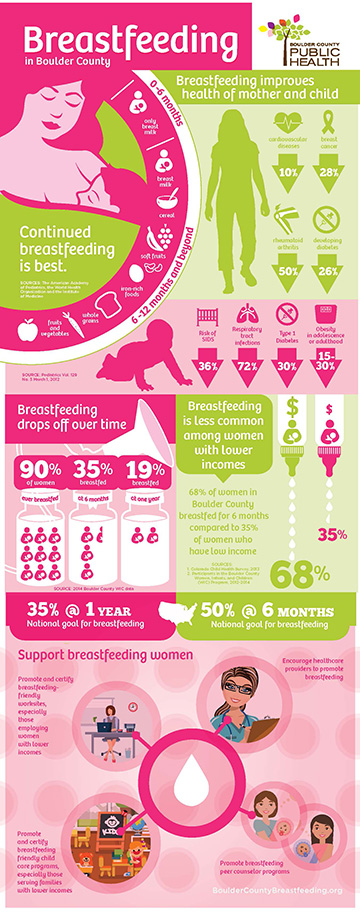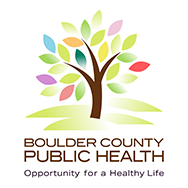Basics of Early Days
Getting breastfeeding off to a good start in the first month will help you to have more options later. Here are some strategies.
- Breastfeed exclusively before you return to work or school so your body will build a strong foundation for making milk.
- Learn to recognize feeding cues and breastfeed whenever your baby shows feeding cues, or at least 8-12 times every 24 hours.
- Learn different positions to nurse your baby and how to know whether the baby has a good latch.
- Avoid using bottles or pacifiers during the first month so baby becomes a pro at breastfeeding.
Building Milk Supply & Stockpiling
Establishing your breastmilk supply early will benefit you when you return to work or school. Here are some tips.
- Try to take at least six weeks maternity leave, if possible, so you will fully recover from childbirth and you and your baby get breastfeeding off to a good start.
- If you must return to work or school sooner, call your Women, Infants, & Children (WIC) peer counselor or a lactation consultant for ways to keep your milk production strong.
- Begin collecting and freezing extra milk (1-3 ounces) about 3-4 weeks before your first day back at work.
- Continue breastfeeding once bottles are started. One of the best ways to keep making enough milk is to nurse your baby often when you are together.
- If you’re going to be away from your baby for more than a couple of hours, you’ll probably want to express your milk. Count the number of times your baby usually breastfeeds every 24 hours. This is your “magic” number to keep steady once you return to work.
- For example, if your baby usually breastfeeds ten times every 24 hours, you will need to either breastfeed or express your milk a total of 10 times every 24 hours once you are back at work. This might mean you breastfeed six times and express milk four times for a total of 10, or once every 2 hours or so. Keeping your magic number steady will ensure your milk production stays high, even when you are away from your baby.
- Remember: every drop of your milk is important! Be proud of any amount of breastfeeding you and your baby can enjoy.
Talking with your Employer or School
By Colorado law, employers MUST provide breastfeeding women with private space (not a toilet stall) and time to express milk at work. Employers may not discriminate against women for expressing milk in the workplace.
Before maternity leave, while pregnant is the best time to start the conversation with your employer or school about your plans for after your baby arrives, including your plan to breastfeed. Most managers will happily support you, but the sooner they know your needs, the more helpful they can be. Here are some tips:
- Tell your employer or school that your doctor recommends that you continue to breastfeed your baby. Tell them you’ll use your usual breaks and lunch period to express milk.
- Create a lactation and work plan and share it with your employer or school.
- Give your employer or school a copy of the Boulder County breastfeeding toolkit for employers.
- After your baby arrives, bring them to work to meet your co-workers. This will help them to be more understanding when you need to take breaks to express milk.
Child Care
Your child care provider can be a valuable support to meeting your breastfeeding goals. Try these tips to ensure they are doing all they can to support you.
- Ask if you can breastfeed at the child care facility before and/or after work or during the meal period.
- Ask your child care provider not to feed the baby shortly before you pick your baby up.
- Let your child care provider know that your baby might start nursing more frequently at night and less during the day. This is called “reverse cycle feeding,” which is normal.
- Clearly label your expressed milk that you take to your child care provider with the date and your baby’s name.
- Provide milk in small quantities (1-3 ounces) to reduce waste.
- Look for a breastfeeding friendly child care provider. If your child care center is not on the list, Boulder County Public Health can help you find out if they support breastfeeding moms.
- Give your child care provider a copy of the Boulder County Breastfeeding Toolkit for Child Care Centers.
- If you are using informal child care such as family, friend, or neighbor care for your child, share this self-guided training, which gives the basics for supporting breastfed children in their care.
Pumping
Pumping takes practice. Don’t be surprised if you only get a little the first few times. Babies are usually much better at removing milk than breast pumps. Here are some tips to make pumping work for you.
- Practice pumping your breast milk in the morning or when your breasts feel fuller.
- Consider purchasing a hands-free pumping bra to keep your hands free to snack or do other things. You can make your own by cutting small holes in the middle of an inexpensive sports bra to keep the pump flange next to your breast, or attach the pump to your bra strap with a hair tie and then attach it to the flange.
- To help your milk flow while you’re away, consider bringing something with your baby’s smell on it, listen to a recording, or look at photos of your baby.
- Store any milk you collect in small quantities (1-3 ounces). Your baby may not take a large amount at one feeding, and your milk is too valuable to waste!
- Ask a lactation consultant, healthcare provider, or the WIC office whether you need a breast pump and which kind is best for you.
- What to Know When Buying or Using a Breast Pump
Bottle
- Wait until about two weeks before you return to work or school to help your baby learn to drink from a bottle.
- Only put a small amount of breast milk (1-3 ounces) in the bottle. These are practice tries right now.
- Offer it when the baby is not super hungry or upset. Some babies are more eager to try something new if they are a little sleepy.
- Ask someone else to offer the bottle. Babies often prefer to nurse when they are with mom.
- Don’t force the baby to accept a bottle. If the baby refuses, try again later.
- Use a bottle with a slow-flow (or newborn) nipple and experiment with different types of slow-flow nipples. Once bottles are started, continue breastfeeding. One of the best ways to keep making enough milk is to nurse your baby often when you are together.
- Learn about and try paced bottle feeding, which mimics breastfeeding.
- Some babies prefer a cup, dropper, or spoon. Some babies “reverse cycle feed.” This means they switch the times they eat by breastfeeding more when their mom is at home and may not take much when their mom is away. This is normal as long as babies get 8-12 feedings in 24 hours.




